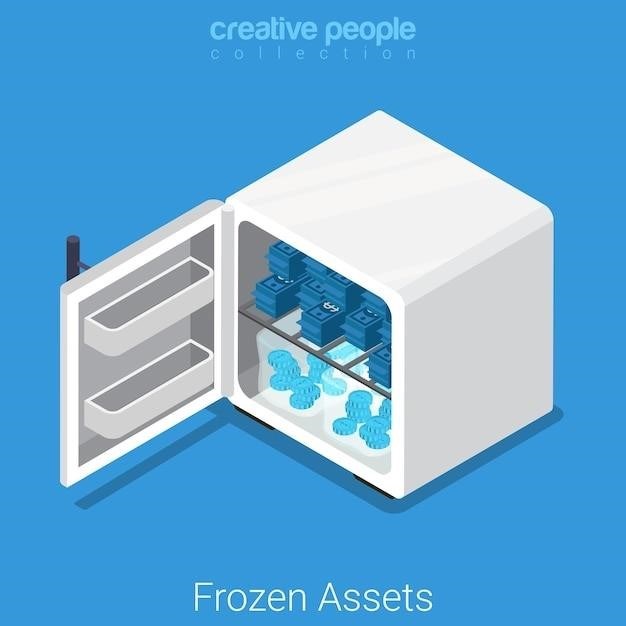GE Profile Nugget Ice Maker Manual⁚ A Comprehensive Guide
This comprehensive guide will walk you through everything you need to know about your GE Profile Opal Nugget Ice Maker, from understanding the unique features of nugget ice to operating and maintaining your appliance. Whether you’re a first-time user or a seasoned ice enthusiast, this manual will provide valuable insights and tips to ensure optimal performance and enjoyment.
Introduction
Welcome to the world of nugget ice, a delightful and refreshing treat that’s taking the culinary world by storm. The GE Profile Opal Nugget Ice Maker is a revolutionary appliance that brings the joy of restaurant-quality nugget ice right to your home. With its sleek design, innovative technology, and user-friendly interface, the Opal is more than just an ice maker; it’s a kitchen essential that elevates your beverage experience.
This manual serves as your comprehensive guide to navigating the features, functionalities, and maintenance of your GE Profile Opal Nugget Ice Maker. From understanding the basics of nugget ice to mastering the intricacies of operation, this manual will equip you with the knowledge you need to get the most out of your appliance.
We’ll delve into the science behind nugget ice, explore the unique features of the GE Profile Opal models, and guide you through the steps of operating, cleaning, and troubleshooting your ice maker. Whether you’re a seasoned ice aficionado or a curious newcomer, this manual will provide valuable insights and tips to ensure optimal performance and enjoyment.
Let’s embark on this journey of icy delight and discover the magic of the GE Profile Opal Nugget Ice Maker.
Understanding Nugget Ice
Nugget ice, often referred to as “chewy ice” or “soft ice,” is a unique type of ice that’s gaining immense popularity for its distinct texture and refreshing qualities. Unlike traditional cubed ice, which tends to be hard and sharp, nugget ice is made up of small, compacted ice flakes that create a pleasantly chewy and melt-in-your-mouth experience.
The process of creating nugget ice involves a series of steps where water is sprayed onto a rotating drum that’s chilled to freezing temperatures. As the water freezes, it’s shaved into thin flakes and then compacted together to form the signature nugget shape. This process results in ice that’s denser than cubed ice, making it slow-melting and ideal for keeping your beverages cool without diluting their flavor.
The unique texture of nugget ice makes it perfect for a wide range of applications, from chilling your favorite cocktails and sodas to adding a touch of coolness to smoothies and iced coffee. Its slower melting rate also makes it an excellent choice for serving water, preventing the drink from becoming overly diluted as the ice melts.
The GE Profile Opal Nugget Ice Maker is designed to produce high-quality nugget ice that’s consistently smooth, chewy, and satisfying. With its innovative technology, you can enjoy the perfect nugget ice for all your beverage needs, bringing a touch of restaurant-quality refreshment to your home.
GE Profile Opal Models
GE Profile Opal Nugget Ice Makers come in a variety of models, each offering unique features and functionalities to cater to different preferences and needs. Here are some of the popular models available⁚
GE Profile Opal 2.0 Nugget Ice Maker with Side Tank (XPIO13SCSS)⁚ This model is a popular choice for its larger capacity, producing up to 38 pounds of nugget ice per day. It features a side tank for added water storage, making it convenient for larger households or frequent ice consumption.
GE Profile Opal 2.0 Nugget Ice Maker (XPIO23SCSS)⁚ This model is a compact and efficient option, offering a capacity of up to 24 pounds of ice per day. It’s perfect for smaller spaces or individuals who don’t need a large ice supply.
GE Profile Opal 1.0 Nugget Ice Maker (P4INAASSTSS)⁚ This model is a more affordable option, offering a capacity of 15 pounds of ice per day. It’s ideal for those who want the convenience of nugget ice without breaking the bank.
GE Profile Opal 2.0 XL Nugget Ice Maker⁚ This model is the largest and most powerful of the Opal line, producing up to 45 pounds of ice per day. It’s perfect for large families or those who entertain frequently.
GE Profile Opal Nugget Ice Maker with Bluetooth Connectivity⁚ This model allows you to control your ice maker remotely using a smartphone app. It also features a convenient timer and settings for customizing your ice-making preferences.
When choosing a GE Profile Opal Nugget Ice Maker, consider your individual needs and preferences, such as ice production capacity, size, and additional features, to find the perfect model for your home.
Key Features of GE Profile Opal Ice Makers
GE Profile Opal Ice Makers are renowned for their exceptional ice-making capabilities and innovative features designed to enhance your ice-making experience. Here are some of the key features that make these appliances stand out⁚
Nugget Ice Production⁚ The hallmark of GE Profile Opal Ice Makers is their ability to produce the highly sought-after nugget ice. This unique type of ice, characterized by its small, chewable, and almost snow-like consistency, is ideal for cocktails, smoothies, and other beverages.
Large Ice Capacity⁚ GE Profile Opal models boast impressive ice production capacities, ranging from 15 to 45 pounds of ice per day. This ensures you’ll have an ample supply of nugget ice on hand, whether for personal use or entertaining guests.
Fast Ice Production⁚ These ice makers are designed for efficiency, producing up to 1.6 pounds of fresh nugget ice per hour. You won’t have to wait long to enjoy a refreshing drink with a generous helping of ice.
Convenient Features⁚ GE Profile Opal Ice Makers come equipped with a variety of user-friendly features, including a clear ice bin, an easy-to-use control panel, and a self-cleaning function. Some models also feature Bluetooth connectivity, allowing you to control your ice maker remotely.
Durable Construction⁚ Built to last, GE Profile Opal Ice Makers are constructed with high-quality materials and are designed to withstand frequent use. The sleek stainless steel finish adds a touch of elegance to any kitchen countertop.
Energy Efficiency⁚ These ice makers are designed to be energy efficient, consuming less power than traditional ice makers. This helps you save money on your energy bills and reduce your environmental impact.
Operating Your GE Profile Opal Ice Maker
Operating your GE Profile Opal Ice Maker is a straightforward process, ensuring you can enjoy refreshing nugget ice with minimal effort. Here’s a step-by-step guide to get you started⁚
Placement and Setup⁚
― Select a level and stable surface to place your ice maker.
― Ensure there is adequate ventilation around the appliance.
ー Connect the ice maker to a standard electrical outlet.
Water Connection⁚
ー Connect the water line to a cold water source, ensuring a secure connection.
ー Some models come with a side tank that needs to be assembled according to the instructions.
Initial Use⁚
― Before making ice for the first time, it’s recommended to run a cleaning cycle.
― Fill the water reservoir with fresh, cold water.
― Turn on the power switch.
― Allow the ice maker to complete its initial ice-making cycle before dispensing any ice.
Dispensing Ice⁚
― Once the ice maker has produced a sufficient amount of ice, you can dispense it into a glass or container.
ー Some models have a convenient ice scoop, making dispensing easier.
Cleaning and Maintenance⁚
― Regular cleaning is essential to maintain optimal performance and hygiene.
― Refer to the cleaning instructions in your user manual for specific steps.
Troubleshooting⁚
― If you encounter any issues, consult the troubleshooting guide in your user manual.
ー If the problem persists, contact GE customer support for assistance.
Cleaning and Maintenance
Regular cleaning and maintenance are crucial for keeping your GE Profile Opal Nugget Ice Maker in top condition, ensuring optimal performance and extending its lifespan. Here’s a comprehensive guide to cleaning and maintaining your appliance⁚
Daily Cleaning⁚
ー Empty the ice bin after each use.
ー Wipe down the exterior surfaces of the ice maker with a damp cloth.
― Clean the water reservoir with warm soapy water, rinsing it thoroughly.
Weekly Cleaning⁚
― Disassemble the ice bin and wash it with warm soapy water.
ー Clean the ice chute and other internal components with a soft brush;
― Rinse all components thoroughly and dry them completely before reassembling.
Monthly Cleaning⁚
ー Run a cleaning cycle using a dedicated cleaning solution.
― Refer to your user manual for specific instructions on using the cleaning cycle.
Water Filter⁚
― Replace the water filter according to the manufacturer’s recommendations, typically every 3-6 months.
― A dirty or clogged water filter can affect ice quality and performance.
Descaling⁚
― Descaling your ice maker is essential to remove mineral buildup that can occur over time.
― Refer to your user manual for instructions on descaling your specific model.
Storage⁚
ー When not in use for extended periods, unplug the ice maker and empty the water reservoir.
― Clean all components thoroughly and dry them completely.
― Store the ice maker in a cool, dry place.
By following these cleaning and maintenance guidelines, you can ensure your GE Profile Opal Nugget Ice Maker remains in pristine condition, providing you with refreshing nugget ice for years to come.
Troubleshooting Common Issues
While the GE Profile Opal Nugget Ice Maker is designed for reliable operation, you may encounter occasional issues. Here’s a guide to troubleshooting common problems⁚
No Ice Production⁚
― Check the Power⁚ Ensure the ice maker is plugged in and the power switch is turned on.
ー Water Supply⁚ Verify that the water supply is connected and turned on.
ー Water Filter⁚ Replace the water filter if it’s clogged or dirty.
― Water Inlet Valve⁚ Check the water inlet valve for proper functioning.
Ice Maker Blinking Yellow⁚
― Cleaning Mode⁚ The ice maker may be in cleaning mode, indicating a need for descaling or a cleaning cycle.
― Refer to the Manual⁚ Check your user manual for instructions on exiting cleaning mode and performing necessary maintenance.
Ice Maker Making Noise⁚
ー Normal Operation⁚ Some noise during ice production is normal, but excessive noise may indicate a problem.
― Check the Water Reservoir⁚ Ensure the water reservoir is properly seated and not making contact with any internal components.
ー Contact Support⁚ If the noise persists, contact GE customer support for assistance.
Ice Not Dispensing Properly⁚
― Check the Ice Bin⁚ Ensure the ice bin is not full and the ice chute is clear of any obstruction.
― Ice Maker Cycle⁚ Allow the ice maker to complete a full cycle before attempting to dispense ice.
Ice Texture Issues⁚

― Water Quality⁚ Hard water can affect ice texture. Use a water filter or consider descaling the ice maker.
― Ambient Temperature⁚ Extreme temperatures can impact ice quality. Ensure the ice maker is placed in a cool, well-ventilated area.
If you’re unable to resolve an issue, contact GE customer support for further assistance.
GE Profile Opal Accessories
Enhance your GE Profile Opal Nugget Ice Maker experience with a range of accessories designed to optimize performance and convenience⁚
GE Profile Opal Cleaning Kit⁚
― Essential for maintaining optimal ice quality and extending the lifespan of your ice maker.
― Includes cleaning solutions and tools specifically designed for descaling and cleaning internal components.
GE Profile Opal Water Filter⁚
― Ensures clean and pure water for ice production.
― Reduces impurities, improves taste, and prevents mineral buildup.
ー Regular replacement is recommended for optimal performance.
GE Profile Opal Side Tank⁚
― Available for select models, providing additional water storage capacity for extended ice production.
ー Reduces the need for frequent refilling and ensures a steady supply of nugget ice.
GE Profile Opal Bluetooth Connectivity⁚
― Enables remote control and monitoring of your ice maker through a compatible smartphone app.
ー Allows you to adjust settings, track ice production, and receive notifications.
GE Profile Opal Replacement Parts⁚
― A variety of replacement parts are available for your ice maker, including ice bins, water reservoir, and internal components.
ー Contact GE customer support for assistance in identifying and ordering the correct parts.
These accessories can enhance your ice maker’s functionality and ensure long-lasting performance.
Safety Precautions
Your safety is paramount. Please read and understand these safety precautions before operating your GE Profile Opal Nugget Ice Maker⁚
Electrical Safety⁚
― Always plug the ice maker into a grounded electrical outlet.
― Do not use extension cords.
― Unplug the ice maker before cleaning, servicing, or moving it.
ー Do not operate the ice maker with a damaged power cord or plug.
Water Safety⁚
ー Only use clean, potable water for ice production.
ー Do not use hot water or liquids other than water in the ice maker.
― Do not fill the water reservoir beyond the indicated line.
Handling and Operation⁚
ー Do not place the ice maker on an unstable or uneven surface.
ー Do not place the ice maker near a heat source or in direct sunlight.
― Do not touch the internal components while the ice maker is operating.
― Always use caution when handling the ice bin, as it may be heavy.
Children and Pets⁚
ー Keep children and pets away from the ice maker.
― Do not allow children to operate the ice maker.
By adhering to these safety precautions, you can ensure a safe and enjoyable experience with your GE Profile Opal Nugget Ice Maker.
Frequently Asked Questions
Here are some frequently asked questions about the GE Profile Opal Nugget Ice Maker⁚
Why is my GE Nugget Ice Maker blinking yellow?
― A blinking yellow light on the display ring around the button indicates that the unit is in cleaning mode. You can find detailed instructions on how to clean your ice maker in the owner’s manual.
How do I get my GE ice maker to make ice?
ー Ensure the ice maker is plugged in and the power switch is turned on. Check the water reservoir to make sure it is filled with clean water. If the ice maker is still not producing ice, consult the troubleshooting section in the owner’s manual.
Why is my GE Profile not making ice?
ー Several factors could be causing your ice maker to malfunction. Check the water filter, as a dirty or clogged filter can reduce water flow. Ensure the water inlet valve is functioning properly. If the ice maker is still not producing ice, contact GE customer support for further assistance.
How do I reset my GE Nugget Ice Maker?
― Unplug the ice maker from the power outlet for 10 seconds. Then, plug it back in and allow it to power up. This will reset the ice maker and may resolve minor issues.
Where can I find the GE Profile Opal Nugget Ice Maker manual?
ー You can download a digital copy of the owner’s manual directly from GE’s website. Simply search for your specific model number on the GE website. You can also find manuals on websites like ManualsLib.
















